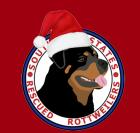|
Many people are discovering the joys of Rottweiler ownership by adopting rescue cases. This is an admirable undertaking and I applaud those who rescue. However, many owners of such dogs avoid obedience training for fear of stressing the dog. They may feel that the dog won’t like them if they make him do obedience. Nothing could be further from the truth and nothing could be more detrimental to the well-being of your dog! In order to bond with your rescue dog, more than plain old love is necessary. Establishing a leadership relationship is also important. While this is true with any dog/owner relationship, it is of particular importance with rescues. Rescue dogs have usually been ignored, and possibly abused by previous owners. It is crucial that they understand you will be fair to them and that they learn to respect your decisions within the pack as final. While Rottweilers are independent, rescues are often more independent because of the necessity of having to fend for themselves in most situations. Many dogs will continue to assume that they must think and act for themselves unless given the opportunity to realize that you will now take over. Assume an attitude of kind benevolence toward the dog. It is not necessary or prudent to dwell on the dog’s past abuse by spoiling the dog. Of course, this article speaks to the average rescue animal situation. Bear in mind that there are always exceptions to the rule. Use caution and respect when attempting new exercises. I am assuming the dog can walk on a leash, and that you have a fenced in yard. I highly suggest that you enroll the dog in a reputable dog obedience class. Look for a well-run class that teaches the basics and practical applications of dog obedience. One of the exercises that you can begin practicing with your dog every day involves getting acquainted, or bonding with the dog.
The Bonding Exercise : Sit with your dog on the floor. If the dog is extremely exuberant, sit in a chair. Have some tasty treats easily accessible. Talk softly to the dog, giving no specific command. Encourage the dog to look at you by praising and smiling.Feed a treat and praise when the dog looks at you. Lovingly speak to the dog for a few minutes, two or three times per day, feeding treats ONLY when the dog is looking at your face. If the dog is pushy, hold the dog back from jumping on you by keeping a hand on the collar. Ignore and do not praise or treat if the dog is jumping up, or not looking at you.Continue this for at least 2 weeks. This will lay the ground work for the Attention command, which is important in all obedience. Encourage all members of the family to do this with the dog. Always supervise children when doing this or any other exercise. Using treats and toys to play with your dog will be a great advantage. The dog learns that learning is fun, and tasty too!! Use praise and play along with treats whenever the dog comes to you. To begin shaping the dog towards a reliable recall, make sure you never call the dog and do something negative. For instance do not yell, put in the bathtub, give medicine or other negative action. If you need to do these things (except yell), go get the dog. You want the dog to always want to come to you instantly because he only gets praise, play and treats if he does! Next time, we will discuss how to work on that reliable come-when-called. Meanwhile, keep the dog safe on lead and in a fenced area at all times. Do not take chances with a loose dog. Now, go forth and bond! The recall is one of the most important exercises that a dog can learn. Rescue dogs will benefit greatly from the Recall game. Because they often associate something bad with being called, they will need the high motivation level of the game. In order to combat the fear, using food reward is the most successful conditioning method. Once the dog is coming to you in a happy manner, you can begin weaning the dog off food. Using toys as a reward is often a good replacement for food. When the dog arrives after being called, a squeaky toy or ball is produced and thrown or used for a game of tug.
The Recall Game : This will not only give the dog exercise, but will begin teaching one of the most important commands a dog learns, the come-when-called. Many dog’s lives have been saved because they responded to the call of their owner instantaneously. The recall game is fairly simple but takes a little longer to establish with older dogs. Make sure you use 100% food reward until the behavior is established, then begin a variable schedule of reinforcing. In addition, drop all pretext of a formal recall while playing the game. No sit in front is necessary. You want to establish a happy and fast recall.
REMINDERS :
If the dog does not respond to a call--DO SOMETHING--and that does not include standing there and repeating the command. Go toward the dog, showing the treat and then running backward. Encourage the dog all the way back to where you were when you first called. The dog only gets the treat when you have touched the collar and taken hold of it gently. This teaches the dog to come all the way to you instead of playing "catch me" games.
HOW TO: Everyone goes to the area where you will play the game. One person holds the dog by the collar and gets in a kneeling/sitting position and the other person goes 10 to 20 feet away and kneels/sits. The dog does not have to sit and stay. Hold the dog quietly while the caller says the dog's name FIRST (happily) and then "come". Hold the treat just in front of you. SMILE. As soon as the dog starts to come, praise, ("good dog, yay"). As soon as the dog gets to you, hold the treat at the dog's nose with one hand, touch and take hold of the collar with the other, and immediately give the treat. When the dog has eaten the treat, nod to the other person and they do the same thing you just did! Go back and forth that way for a few minutes, quit when the dog is getting tired or seems to be losing interest. Keep treats around the house and be ready to treat if he responds to a call. NEVER call if you are not ready to follow through. If you call and he comes, YAHOO, treat and praise.If he doesn't, go find him, show him a treat and praise him all the way back to where you first called.
VARIATION : Have someone hold the dog while you run quickly to a hiding place, then call. The person holding him lets go and runs with him to find you, letting him do all the work. You praise, touch the collar and give the treat when he finds you. This game can be a real ice-breaker with rescue dogs. It gives the dog a great energy outlet, something to do with the whole family, and a positive introduction to learning. It can be utilized from the first day a rescue arrives at the new home.
by Barb McNinch |


















